 12-30-2011, 08:08 PM
12-30-2011, 08:08 PM
|
#5
|
|
Grizzled Veteran
|
Round 2
B. Swartz(Unr) v. J. Lemon(826)
1.d4 Nf6 2.c4 g6 3.Nc3 Bg7 4.Bf4?!
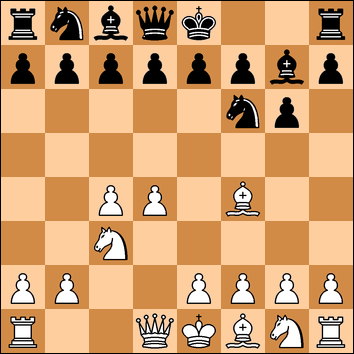 This is the point at which I wasn't really sure what to do. I'm a 1. d4 player so the KID didn't surprise me, but I always feel unsure with my bishops, not sure where they should be. My sense in looking back at the game was that this was not a particularly good placement.
I took a look at some high-level games and found that Bg5 is more common, and also that e4(which I felt was a risky over-extension at the time) is the most popular idea for white. All of this is logical, since Bf4 ignores the main fight which is at the moment around d5.
4...d6
This surprised me, I would have expected d5 here. I did not think enough on the fact that Black is obviously preparing an e7-e5 push.
5. e3 O-O 6. Bd3 Re8 7. Nf3 Nc6
This is the point at which I wasn't really sure what to do. I'm a 1. d4 player so the KID didn't surprise me, but I always feel unsure with my bishops, not sure where they should be. My sense in looking back at the game was that this was not a particularly good placement.
I took a look at some high-level games and found that Bg5 is more common, and also that e4(which I felt was a risky over-extension at the time) is the most popular idea for white. All of this is logical, since Bf4 ignores the main fight which is at the moment around d5.
4...d6
This surprised me, I would have expected d5 here. I did not think enough on the fact that Black is obviously preparing an e7-e5 push.
5. e3 O-O 6. Bd3 Re8 7. Nf3 Nc6
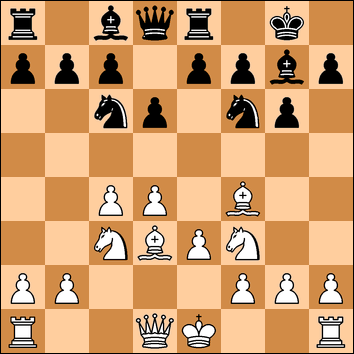 A key moment. I was concerned about 8 ... e5, which Black probably would have played if I did something passive here. After 9. dxe5 dxe5 my f4-bishop would be looking rather stupid as it has to go to g5 or retreat to g3. In either case, Black's center would be better I think.
The only way I could find to stop this was to chase the c6 knight away.
In retrospect, I think it would have been best to castle via 8. 0-0 e5 9. Bg5!, pinning the knight on f6 and preventing Black from benefiting from the pawn fork 9 ... e4.
8.d5 Nb4 9. Bb1
I didn't want to allow him to trade knight for bishop, and this avoids it. I didn't even think about Be2 ... However, I think I should have more seriously considered castling here as well. This looks to me to provide a more promising game in terms of initiative and solidity, i.e. 9. 0-0 Nxd3 10 Qxd3
9...e5 10.dxe6?!
A key moment. I was concerned about 8 ... e5, which Black probably would have played if I did something passive here. After 9. dxe5 dxe5 my f4-bishop would be looking rather stupid as it has to go to g5 or retreat to g3. In either case, Black's center would be better I think.
The only way I could find to stop this was to chase the c6 knight away.
In retrospect, I think it would have been best to castle via 8. 0-0 e5 9. Bg5!, pinning the knight on f6 and preventing Black from benefiting from the pawn fork 9 ... e4.
8.d5 Nb4 9. Bb1
I didn't want to allow him to trade knight for bishop, and this avoids it. I didn't even think about Be2 ... However, I think I should have more seriously considered castling here as well. This looks to me to provide a more promising game in terms of initiative and solidity, i.e. 9. 0-0 Nxd3 10 Qxd3
9...e5 10.dxe6?!
[i] This move is quite natural of course, but reveals a flaw that I'm seeing in my thought process over and over. When considering or even forcing an exchange, I don't adequately consider what the position will look like afterwards.
The last several moves my center has been getting undermined, but the game was still even. After this trade, CMX shows Black with a clear if small edge. My king is still in the center which is opening up, the c4-pawn is under attack and looking like it may be a liability, Black has better development and initiative has clearly swung away from me.
Allowing the e5 pawn to remain via 10. Bg5(or a little worse, 10. Bg3) and the g7-bishop is only a tall pawn and Black's light-squared bishop will have a much tougher time finding a home, among other plusses.
10...Bxe6 11.Qe2
Defending c4. I didn't think b3 was advisable due to how weak I'd be on the a1-h8 diagonal, things like Ng4 would be possible and the queenside looks ugly.
I considered Qb3?! briefly but missed a lot of things - including that it ultimately fails due to my king still being in the center.
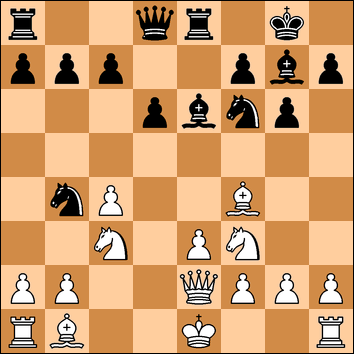 11...d5 12.a3 Nc6 13.cxd5
A trade I felt I had to make, but which helps my opponent.
13...Nxd5 14.Nxd5 Qxd5 15.O-O
I felt I was in a lot of danger here and needed to get my king safe. Black's pieces are definitely better placed.
11...d5 12.a3 Nc6 13.cxd5
A trade I felt I had to make, but which helps my opponent.
13...Nxd5 14.Nxd5 Qxd5 15.O-O
I felt I was in a lot of danger here and needed to get my king safe. Black's pieces are definitely better placed.
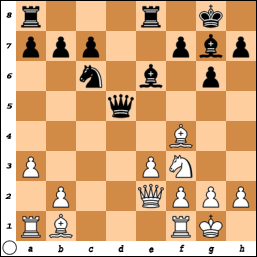 15...Qb3
Trying to attack immediately, but he missed a couple of moves in the next sequence.
16.Ba2 Qb6
Best for Black was 16 ... Qxb2 17.Qxb2 Bxb2 18.Rab1 Bxa3 19.Bxe6 Rxe6 20.Rxb7 leading to a chaotic situation with rough equality.
17.Bxe6 Rxe6 18.Rfd1 Bxb2? 19.Bxc7
My opponent didn't see this move, but both missed the superior Rab1!, which wins the bishop.
15...Qb3
Trying to attack immediately, but he missed a couple of moves in the next sequence.
16.Ba2 Qb6
Best for Black was 16 ... Qxb2 17.Qxb2 Bxb2 18.Rab1 Bxa3 19.Bxe6 Rxe6 20.Rxb7 leading to a chaotic situation with rough equality.
17.Bxe6 Rxe6 18.Rfd1 Bxb2? 19.Bxc7
My opponent didn't see this move, but both missed the superior Rab1!, which wins the bishop.
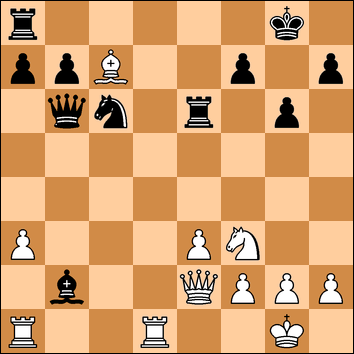 19...Qxc7 20.Qxb2 Rd8 21. Ng5 Red6 22. Rxd6 Qxd6
I, and the other players at the event, both felt I was still a little worse here. the a3 pawn is a liability, Black's probably got a superior endgame. Concerned about Ne5, I played my next move knowing it was probably bad but unable to think of anything better.
19...Qxc7 20.Qxb2 Rd8 21. Ng5 Red6 22. Rxd6 Qxd6
I, and the other players at the event, both felt I was still a little worse here. the a3 pawn is a liability, Black's probably got a superior endgame. Concerned about Ne5, I played my next move knowing it was probably bad but unable to think of anything better.
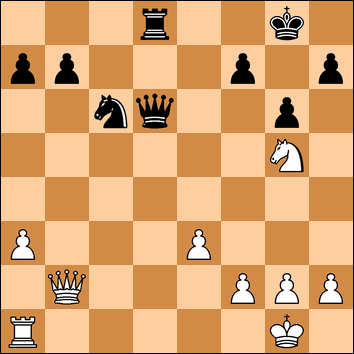
Completely on accident, my next move also stops the threat I totally did not see: 23 ... Qd1+! 24. Rxd1 Rxd1#.
23. f4?! h6 24. Ne4 Qe7??
This move objectively loses the game. I never saw it though, even in looking through the moves afterwards, until my computer showed me the line. 24 ... Qe6 was more accurate.
25. Nf6+ Kf8 26. Nh7+?
This eventually forces a draw by repetition, but misses the winning sequence of 26 Nd5!! when Black cannot defend against the dual threats of Nxe7 and Qh8 checkmate. White will have a queen for a knight at worst - a winning material advantadge.
26...Ke8 27. Nf6+ Kf8 28. Nh7+ Ke8 29. Nf6+ Kf8
Draw by three-fold repetition agreed, the first such ending to a game I've ever played.
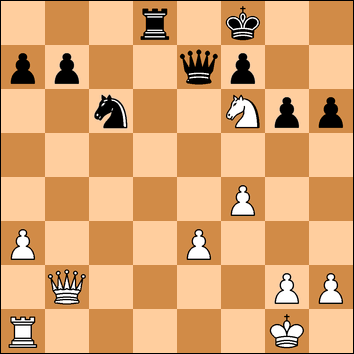 |

|

|